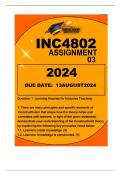,INC4802 ASSIGN MENT 3
Question 1: Learning theories for Inclusive Teaching
1. There are many principles and specific elements of Constructivism that shape
how the theory helps and correlates with learners. In light of the given statement,
demonstrate your understanding of the Constructivist theory by explaining the
following key principles listed below:
1.1. Learners create knowledge. (5)
Constructivist theory says that learners don't just receive information, but
instead, they actively create their own knowledge (Piaget, 1972). This happens
when learners engage with the world, ask questions, experiment, and reflect on
their experiences. Through this process, learners build new knowledge structures
and develop cognitively.
Social interaction also plays a crucial role in learning, as learners co-construct
knowledge through collaborative activities and dialogue with others (Vygotsky,
1978). This means that education should focus on providing learners with
opportunities to explore, discover, and create meaning from their experiences.
1.2. Learners’ knowledge is constructed.
In constructivism, knowledge is seen as something that learners build over time
(Fosnot, 1996). Learning involves connecting new information to existing
cognitive structures, and teachers can support this process through scaffolding
(Bruner, 1966). This means building on learners' prior knowledge and guiding
them to higher levels of understanding.
Constructivism suggests that learners don't passively absorb information, but
instead, they actively organize and interpret it based on their prior experiences
and cognitive frameworks. Learning is a continuous process of constructing and
, reconstructing understanding through interaction with the environment and
social context (Fosnot, 1996).
References:
Bruner, J. S. (1966). Toward a Theory of Instruction. Harvard University Press.
Fosnot, C. T. (1996). Constructivism: Theory, Perspectives, and Practice. Teachers
College Press.
Piaget, J. (1972). The Psychology of the Child. Basic Books.
Vygotsky, L. S. (1978). Mind in Society: The Development of Higher Psychological
Processes. Harvard University Press.
2. In your views, as an inclusive education practitioner, what is the role of a
teacher in a constructive classroom setting?
In a constructivist classroom, teachers don't just teach - they facilitate learning.
They create an environment where students feel encouraged to explore, ask
questions, and solve problems (Brooks & Brooks, 1993). Teachers design activities
that promote hands-on learning, allowing students to actively participate in their
own learning process.
Teachers also act as scaffolds, providing support and gradually removing it as
students become more confident (Vygotsky, 1978). They guide students through
the learning process, helping them connect new information with what they
already know. Teachers ask questions, encourage critical thinking, and help
students reflect on their learning experiences (Bruner, 1961).
In a constructivist classroom, teachers also create opportunities for collaborative
learning. They organize group activities and discussions, promoting social
interaction and collective knowledge building (Johnson & Johnson, 1999).




